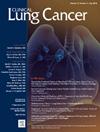Perioperative Outcomes of Neoadjuvant Therapy in Resectable Lung Cancer Patients With Endobronchial Disease in the Era of Personalized Medicine
IF 3.3
3区 医学
Q2 ONCOLOGY
引用次数: 0
Abstract
Background
Lung cancer remains the leading cause of cancer-related deaths worldwide. Recent studies have highlighted the benefit of neo-adjuvant therapies in the treatment of resectable stage IB to IIIA cases which will likely increase the use of neoadjuvant therapies (NAT) across multiple stages, both earlier and later. This includes the combination of chemotherapy and immunotherapy as well as the more widespread use of targeted therapies with or without the addition of radiation.
This heterogenous group of resectable tumors includes proximal tumors with different levels of endobronchial involvement and secondary distal atelectasis and sometimes superimposed infections which adds a level of concern and complexity when using NAT. In this study, we evaluate the prevalence of endobronchial lesions in patients treated with NAT, as well as the rate of associated complications.
Patients and Methods
Data was obtained from a prospectively maintained thoracic surgery database, the Thoracic Oncology Clinical Database and Biobank. Patients with proven clinical stage II-III NSCLC that underwent resection within the Division of Thoracic Surgery at the McGill University Health Centre (Montreal, QC, Canada) from January 2015 to December 2020 were included.
Chest computed tomography scans prior to neoadjuvant therapy were reviewed by 2 senior thoracic surgeons to establish the presence of an endobronchial tumor lesion. The presence of an endobronchial lesion was defined by a tumoral lesion obstructing a bronchus or several bronchi AND responsible for lung atelectasis distally (with at least 1 occluded segment). Treatment-related and postoperative complications were collected retrospectively by reviewing patient charts.
Results
Overall, 110 patients met the inclusion criteria, of which 37/110 patients had endobronchial lesions before starting neoadjuvant therapy (33.6%). These patients had a higher rate of global complications 23/37 (62.2%) during neoadjuvant treatment compared to patients without obstruction 30/73 (41.1%) (P = .04). There was no difference in terms of severity of complications between the 2 groups (P = .34). The group with endobronchial lesions was found to have an increased rate of pulmonary complications, of which there were none in the other group (5/37, 13.5% vs. 0/73, 0%, P = .004). There were 2 cases of patients requiring urgent surgeries before completing NAT due to pulmonary complications in the endobronchial lesion group (2/37, 5.4%) and none in the group without obstruction.
Conclusion
Patients who are treated with NAT for locally advanced resectable lung cancer usually have larger tumors, where it is not uncommon to encounter endobronchial lesions responsible for downstream obstruction. In this study, the prevalence of endobronchial lesions was found to be 1 third of the patients undergoing NAT. The presence of endobronchial disease was associated with increased risk of complications during neoadjuvant treatment. These complications presented more frequently as pulmonary complications and required in some cases urgent surgical resection. Therefore, patients with endobronchial tumors undergoing NAT should be identified as a high-risk group and would likely benefit from closer clinical follow-up.
个性化医疗时代可切除肺癌患者支气管内疾病的新辅助治疗围手术期疗效。
背景:肺癌仍然是全球癌症相关死亡的主要原因。最近的研究强调了新辅助疗法在治疗可切除的 IB 期至 IIIA 期病例中的益处,这可能会增加新辅助疗法(NAT)在多个分期(包括早期和晚期)中的使用。这包括化疗和免疫疗法的结合,以及靶向疗法在放疗或不放疗情况下的更广泛应用。这组可切除肿瘤的异质性包括不同程度的支气管内膜受累的近端肿瘤、继发性远端肺不张以及有时叠加的感染,这增加了使用 NAT 时的担忧和复杂性。在这项研究中,我们评估了接受 NAT 治疗的患者中支气管内病变的发生率以及相关并发症的发生率:数据来自一个前瞻性维护的胸外科数据库、胸部肿瘤临床数据库和生物库。纳入了2015年1月至2020年12月期间在麦吉尔大学健康中心(加拿大昆士兰州蒙特利尔市)胸外科接受切除术的已确诊临床II-III期NSCLC患者。新辅助治疗前的胸部计算机断层扫描由两名资深胸外科医生进行审查,以确定是否存在支气管内肿瘤病变。支气管内肿瘤病变的定义是肿瘤病变阻塞了一条支气管或数条支气管,并导致远端肺不张(至少有一段闭塞)。通过查看患者病历回顾性地收集了与治疗相关的并发症和术后并发症:共有 110 例患者符合纳入标准,其中 37/110 例患者在开始新辅助治疗前有支气管内病变(33.6%)。与无梗阻的患者30/73(41.1%)相比,这些患者在新辅助治疗期间的总体并发症发生率更高,为23/37(62.2%)(P = .04)。两组患者的并发症严重程度没有差异(P = .34)。发现支气管内病变组的肺部并发症发生率增加,而另一组则没有(5/37,13.5% vs. 0/73,0%,P = .004)。支气管内病变组有2例患者在完成NAT治疗前因肺部并发症而需要进行紧急手术(2/37,5.4%),而无梗阻组则没有:结论:接受NAT治疗的局部晚期可切除肺癌患者通常肿瘤较大,遇到支气管内病变导致下行阻塞的情况并不少见。本研究发现,接受 NAT 治疗的患者中有三分之一存在支气管内病变。支气管内病变的存在与新辅助治疗期间并发症风险的增加有关。这些并发症更多地表现为肺部并发症,在某些情况下需要紧急手术切除。因此,接受新辅助治疗的支气管内肿瘤患者应被确定为高危人群,并可能从更密切的临床随访中获益。
本文章由计算机程序翻译,如有差异,请以英文原文为准。
求助全文
约1分钟内获得全文
求助全文
来源期刊

Clinical lung cancer
医学-肿瘤学
CiteScore
7.00
自引率
2.80%
发文量
159
审稿时长
24 days
期刊介绍:
Clinical Lung Cancer is a peer-reviewed bimonthly journal that publishes original articles describing various aspects of clinical and translational research of lung cancer. Clinical Lung Cancer is devoted to articles on detection, diagnosis, prevention, and treatment of lung cancer. The main emphasis is on recent scientific developments in all areas related to lung cancer. Specific areas of interest include clinical research and mechanistic approaches; drug sensitivity and resistance; gene and antisense therapy; pathology, markers, and prognostic indicators; chemoprevention strategies; multimodality therapy; and integration of various approaches.
 求助内容:
求助内容: 应助结果提醒方式:
应助结果提醒方式:


